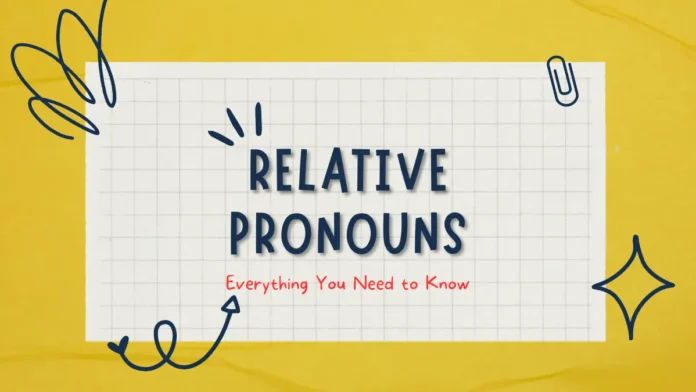Relative pronouns are essential to English grammar and can often be confusing to understand. In addition, we’ll break down what relative pronouns are, when they should be used, and how you can use them correctly in your sentences.
TABLE OF CONTENT
- What are Relative Pronouns?
- Examples of Relative Pronouns in Sentences.
- Restrictive and Nonrestrictive Relative Pronouns.
- Relative Pronouns Exercises
What are Relative Pronouns?
Relative pronouns are pronouns that are used to link a dependent clause to a main clause in a sentence. They are also called “relative” because they relate to a noun or pronoun mentioned earlier in the sentence, and they connect the two parts of the sentence together.
- Who: refers to the subject of a sentence
- Whom: refers to an object of a sentence
- Which: refers to animals and things
- That: persons, animals, and things
- Whose: refers to possession
In addition to these five relative pronouns, some dialects of English also use “where” and “when” as relative pronouns to refer to time and place.
- When: refers to a time
- Where: refers to a place
Examples of Relative Pronouns in Sentences
- A woman teaches us French. The woman has a beautiful car.
The woman who/that teaches us French has a beautiful car
- A bird is on the tree. The bird is singing.
The bird which/that is on the tree is singing
- I met a boy yesterday. The boy was my cousin.
The boy whom I met yesterday was my cousin
- The government helps low-income families. Their children go to school.
The government helps low-income families whose children go to school
- Summer is a season. Many people love to go to the beach in summer.
Summer is a season when people love to go to the beach
- Morocco is a beautiful country. Many tourists love to spend their holidays in Morocco.
Morocco is a beautiful country where many tourists love to spend their holidays in
Understanding Restrictive and Nonrestrictive Relative Pronouns
Knowing relative pronoun types is vital to correctly understanding the difference between a restrictive and nonrestrictive clause. At the same time, both are introduced by a relative pronoun such as “who,” “whom,” “whose,” “which,” or “that,” the distinction lies in their usage. Restrictive clauses identify which noun or pronoun they modify, while nonrestrictive clauses provide extra information not essential to the sentence’s meaning, usually set off with commas.
Here’s an example of a restrictive clause:
- The woman who is wearing a red dress is my sister.
In this sentence, the relative clause “who is wearing a red dress” is essential to identify which woman is being referred to. Without the clause, it’s unclear which woman is being talked about.
The woman who is wearing a red dress is my sister.
By contrast, a nonrestrictive clause can be seen in
- My sister, who is wearing a red dress, is coming to dinner.
The relative clause “who is wearing a red dress” offers additional details but doesn’t influence the sentence’s meaning. It can be omitted without affecting the meaning of the sentence.
Relative Pronouns Exercises
Coming soon




THANKS TEACHER NABIL
Any time 🙂
Thank you
Tr Nabil meant that we use “whom” for a person who is the object of a verb …. Not object as car or table…
in fact Mr Anonymous, we use it for what?